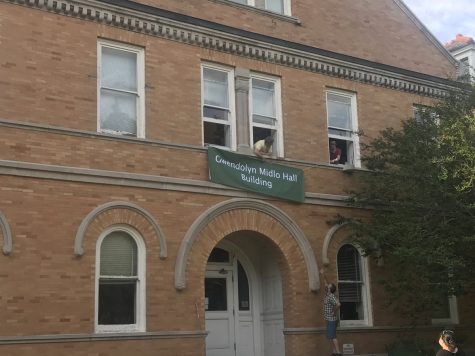Building renaming efforts nationwide call into question who really belongs on campus

In 2017, three then-members of Undergraduate Student Government, Shahamat Uddin, Sonali Chadha and Juharah Worku created legislation to rename Hebert Hall on the academic quadrangle. Inspired by Student Organizing Against Racism’s Tours of Truth, the legislation sought to uncover and address the exclusionary legacy of the building’s namesake.
F. Edward Hebert was a Tulane University alumnus and member of Congress. He went on to hold the record for most consecutive terms in the House of Representatives of any Louisiana House member. However, Hebert ran on a segregationist platform and contributed to the Southern Manifesto, a document pushed by southern lawmakers that attempted to define desegregation as a violation of the constitution.
The legislation passed in the USG Senate, the Graduate and Professional Student Association and University Senate. University Senate’s student affairs committee, along with various offices of the administration, prevented the renaming from officially taking place, Uddin said. Despite the resurgence of this campaign with the history department’s de facto renaming of Hebert this summer, there has been no public action set in place to address Hebert, nor other campus buildings under scrutiny, such as Gibson Hall.
These initiatives have not been isolated movements. Students on campuses nationwide have mobilized to reckon with the sepratist legacies of important campus figures. At University of Minnesota, students compiled and presented damning research on Lotus Coffman, after whom their student union is named, in regards to his promotion of racist and anti-Semitic policies on campus. Similarly, at University of Wisconsin-Madison, students have urged the administration to remove a statue of Abraham Lincoln on the grounds of his anti-Black and anti-Native history.
Under the current political climate, it’s more crucial than ever that universities confront the legacies of their benefactors and act appropriately to rectify them. The politics of representation that surround the names of campus buildings are impossible to evade. Campus buildings shine a light on who and what the university considers important. Just last year, Tulane renamed the formerly Willow Residences into Décou-Labat Residences, after the first Black undergraduate alumni of Newcomb College and Tulane.
Tulane, a predominantly white institution, was quick, like many other schools, to send messages to students empathizing with the murders of George Floyd, Breonna Taylor and Ahmaud Arbery. Despite these stances of compassion and grand gestures like the renaming of Décou-Labat, the university has failed to listen to the action steps students have pushed for. Hebert, Gibson and other sites remain unchanged. No equity fee has yet to be established, despite USG overwhelmingly voting in its favor.
Tulane’s failure to provide genuine improvements to the state of inclusivity on campus is only another installment in a long line of PWIs’ tradition of excluding minority students on campus, which in New Orleans, may also mean excluding the very community that surrounds it. Tulane’s administration’s actions, or lack thereof, call into question who this university is for.
The changing of building names on campus should not be the end of Tulane’s actions to make itself more accessible, and it has been proven to be possible. Oregon State University, University of Oregon, University of Michigan and University of Southern California have all begun dealing with the legacies of various building namesakes. No student should be forced to live in or attend class in a building named after someone whose legacy harms them.
Your donation will support the student journalists of Tulane University. Your contribution will allow us to purchase equipment and cover our annual website hosting costs.



BThiv • Sep 26, 2021 at 11:07 pm
Actually there will be no justice until Tulane University is renamed. Paul Tulane was a Confederate sympathizer after all. In fact more than renamed I think it needs to be raised and completely rebuilt using white slave labor. It should shed the vestiges of teaching in the English language and adopt Swahili or Urdu for its teaching language. Furthermore it should not use electricity is that too was harnessed originally by white people.
Richard Lee • Nov 14, 2020 at 8:34 am
Leave the buildings alone.Nobody is or was perfect including the young Radicals who want to destroy history. What have these young people accomplished that they think they can abolish Tulane history?
They should probably join the Taliban who blew up priceless artifacts that stood for thousands of year because they didn’t agree with the builders.
Monument destruction is the action of bigots and thugs and those that hate everything.
History is what teaches right from wrong and if there is disagreement we should study it, not destroy.
Bruce Hines • Nov 13, 2020 at 10:54 pm
I think you are going to find that all mankind falls short of perfection. Even you fall short. I’ll bet I can find a reason, given your logic, to not honor anyone. Maybe in the quest for socialism, this is inevitable.
SusanGuidry • Nov 12, 2020 at 8:55 pm
Elaine Cunningham was Homecoming Queen 1968! Beautiful , smart African American Newcomb student!
William klein • Nov 12, 2020 at 7:38 pm
Your emphasis of racial identity is by definition racist. You should stop this childish behavior.
Ron • Nov 12, 2020 at 4:54 pm
Some buildings should be renamed, and some monuments taken down. But IMO more people might be swayed if the author had avoided citing the removal of Abraham Lincoln approvingly as a precedent. Be serious. If some feel Lincoln is undeserving of honors they are entitled to that view, but if the goal is to persuade and actually get results, a line will have to be drawn somewhere.